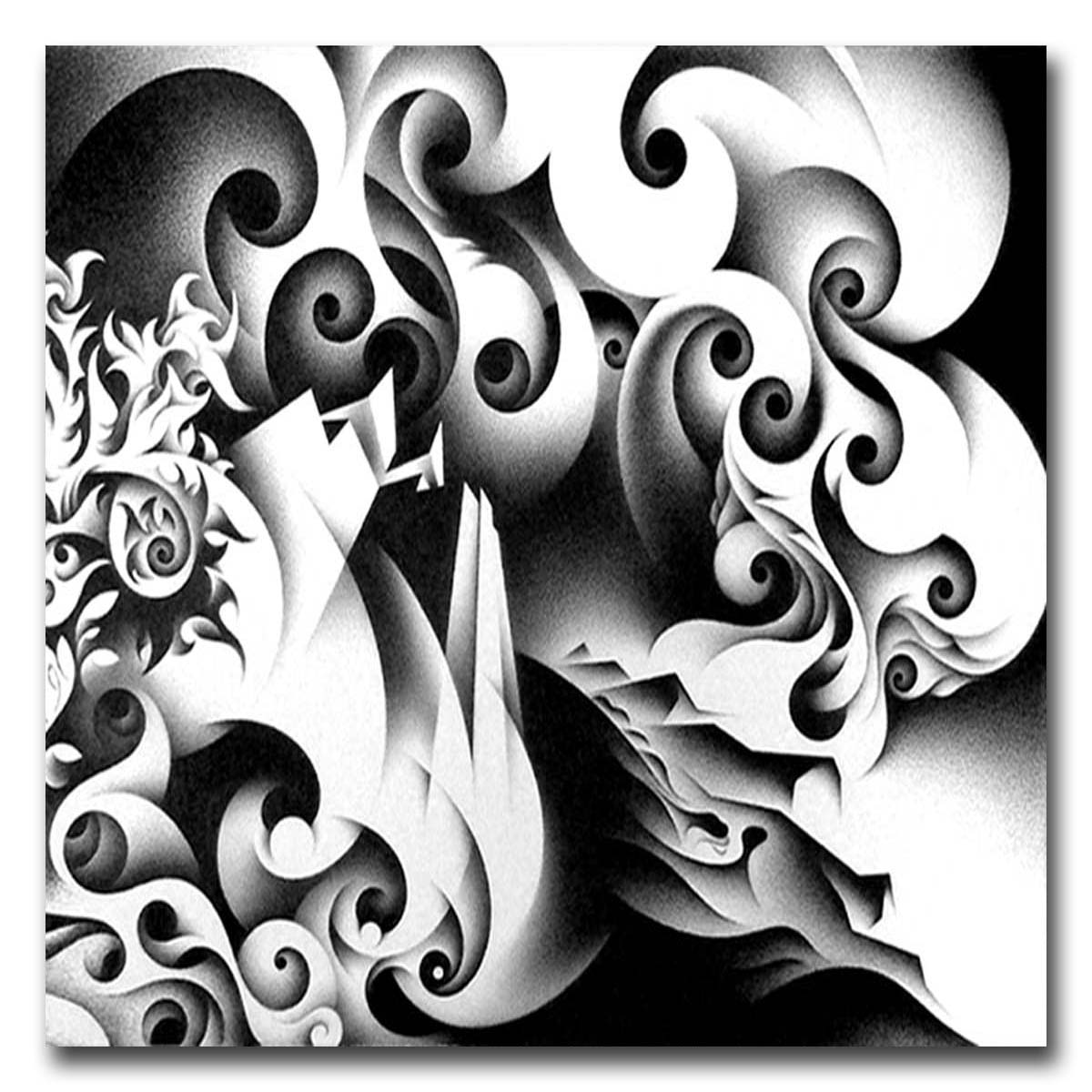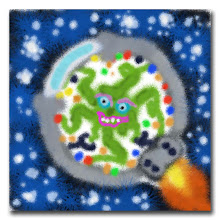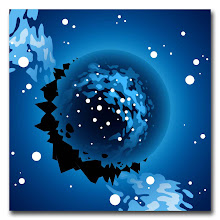Saturday, August 6, 2011
Friday, November 20, 2009
'The Artist's Signature' - Pages & Art

The above image is my title plate/opening shot. And the one below is the beach of the imagination. I often find that my concept art enhances my writing, and vice versa.

TAS Online 01
I have quite a bit more written than this, nearly two-hundred pages of script, with around fifty pages of background and techy stuff, not to mention a lot of concept art. I know two-hundred pages is a pretty long movie. But I write everything down, and toss the awful bits later. I have a solid beginning, and a terrific ending. I just need to flesh out the middle a little more and I've got a pile of paper that no one will ever look at twice.
I think a movie should be a unified whole, both verbally and visually. I've worked out a way of incorporating pi into the basic design motif of the entire film.
My take on a film version of 'Contact' is that the 'download' should constitute the body of the movie. Start with Ellie on the beach, more or less, visualize her unwound memories, and then return to 'reality' about three-quarters the way in. This allows far more freedom than a straight linear telling. I can jump around in time the way a mind at rest naturally meanders from place to place.
It occurs to me that Zemeckis may have been trying to do exactly this with the eye 'pull out' and 'push in' at the beginning and near the end of the film. But subtlety is relative, and in this case is lost in background noise.
Anyway, I think this material deserves better.
Saturday, November 14, 2009
Contact Apologetics: An Open Letter to Whom it May Concern
To mark the anniversary of Carl Sagan’s 75th birthday, the big man was remembered publicly by those many people who worked with him and knew him best. I especially appreciate the personal remembrances as I have been a great fan of Carl Sagan since Cosmos in 1980.
But I am less appreciative of, and far more resentful and confused by the glowing references I heard regarding the movie Contact.
So I’d like to ask a few questions…
Is there a cut of this film of which I am unaware?
I love movies. I am aware that film crews shoot more scenes than appear in the final release. And owing to the flexibility of the market, director/writer/extended version cuts are often available with the original artistic vision restored. This is especially true of films with a richness of content that exceed the imaginative limitations of a studio.
I’ve seen Contact a few dozen times now and I honestly don’t know what warrants such universal praise among Sagan devotees. Maybe it because he died too young and so close to the film's release and people are just being polite.
But it's been some time now and I have yet to see a re-edit, re-release, special edition, tenth anniversary, redeaux... something that would indicate this movie was anything but a lowest-bidder contract job. There are no deleted scenes, no penetrating commentary. No one bothers to deconstruct its hidden meaning, its symbolism, its camera-work, because there is nothing to deconstruct. No one cares because there is nothing to care about.
What Contact lacked in content it made up for in superficiality.
I’ve seen Contact a few dozen times now and I honestly don’t know what warrants such universal praise among Sagan devotees. Maybe it because he died too young and so close to the film's release and people are just being polite.
But it's been some time now and I have yet to see a re-edit, re-release, special edition, tenth anniversary, redeaux... something that would indicate this movie was anything but a lowest-bidder contract job. There are no deleted scenes, no penetrating commentary. No one bothers to deconstruct its hidden meaning, its symbolism, its camera-work, because there is nothing to deconstruct. No one cares because there is nothing to care about.
What Contact lacked in content it made up for in superficiality.
Are there other people out there in the universe down here on Earth?
I was under the distinct impression from episode 13 of Cosmos that ‘We are one planet.' But the radio broadcasts in the opening scene of Contact are from almost exclusively American sources.
Well, are we one planet or not?
Saturday, November 7, 2009
Happy Carl Sagan Day!

Today marks the First Annual Carl Sagan Day... observed two days before what would have been his 75th birthday. Official observations will be held in Florida.
Besides the novel Contact, Cosmos is to me the best of his public works. So nerd up, gather some friends, and watch your favorite episode to celebrate the life of this very important person.
Monday, November 2, 2009
CARL SAGAN DAY

The first annual 'Carl Sagan Day' will be observed on November 7th, 2009... two days before what would have been his 75th birthday. I wish I could go.
Sunday, October 25, 2009
Apparent Brightness

So as not to be accused of being all ass kissy about Kubrick, let me point out a longstanding peeve. The aperture of a camera must be wide open to capture faintly visible objects like background stars. But when a bright object like the day side of the moon, and particularly the sun, is in frame, the aperture is nearly closed and the chance of those very dim and distant background stars registering is nil.
Are you listening, you idiot moon hoax 'I can't see stars in the Apollo footage' ass hats?
For as long as there's been celluloid, there has been an assumption of audience stupidity by film and television studios that wrongly perpetuates the convention that stars are always visible in space. But in space, light is not just relative, it's very relative. It's ironic that this Hollywood falsehood lead to such a monumental misunderstanding of real life.
'I know the real footage of the moon landings I saw was faked, because the faked footage of the moon landings I saw looked so real... obviously.'
In 2001, Kubrick either didn't know he was doing anything wrong, or went along with it for the sake of his little movie.
It's a minor detail and not really worth mentioning. But I went ahead anyway and made these illustrations to show how 2001's opening shot should have looked...
The background stars would be visible behind the eclipse of the moon until the instant the sun breaches the horizon. At that moment the stars would vanish, owing to the new camera setting which requires a smaller aperture so that details on the moon can be seen. Otherwise the moon would be washed out and the sun too bright. Think of exiting a darkened movie theater on a bright sunny afternoon. The eye constantly adjusts to differing degrees of light.
Also, a crescent would advance along the top of the moon as it descends out of frame. Same goes for the Earth...


Tuesday, October 20, 2009
Life... in Pictures

I don't think I can ever adequately express the feeling I had the first time I saw '2001: A Space Odyssey.'
Tenth grade, 1982. My English Lit teacher showed us a horrid, non-letter boxed, pan&scan version on a twenty-four inch TV to kill the last few days before Christmas break. Despite the lousy format, I was floored.
I remember having seen a few photo stills of 2001 in my various scifi/special effects genre books, but they never engaged me, flat as they were. Without music, I guess, and motion, they had no depth.
Our teacher couldn't stuff the whole film into a fifty minute class. But on first viewing he managed to get to the flying bone transition before the lunch buzzer rang. I was hooked. I couldn't wait to get to school the next day.
I've seen it a hundred times since. But strangely, when thinking back on my first few viewings, I had the distinct impression of having seen the film in black and white. Maybe my brain misinterpreting its starkness, and desaturated my memory. When I watch it now I am often surprised by the amount of color it contains.
I don't ever remember feeling a lot of empathy for a Kubrick character (Spartacus aside). Kubrick doesn't do that. I am always very interested in what they're doing. But how they're feeling doesn't leap off the screen and into the audience. It stays up there.
There's an imaginary narrative at the beginning of each chapter of the book 'Galaxies,' by Timothy Ferris. It describes a relativistic, near-light speed spaceship journey across the universe. The explorers outlive the Earth and Sun, not to mention their loved ones, by trillions of years as they plow through intergalactic space toward the edge of the ever expanding visible universe. That's how 2001 made me feel. Lost in the void... in a good way.
After we finished the movie I went to the school library and found the book upon which it was based. I tore through it, and everything else I could find by Arthur C. Clarke. I didn't realize it at the time, but while Clarke certainly contributed, he wasn't actually the person responsible for the visual mind trip that was the movie. It was Stanley Kubrick who made this thing possible. Watch, 'A Life in Pictures,' which beautifully details his technique.
Monday, October 19, 2009
Tuesday, October 13, 2009
Subscribe to:
Comments (Atom)










